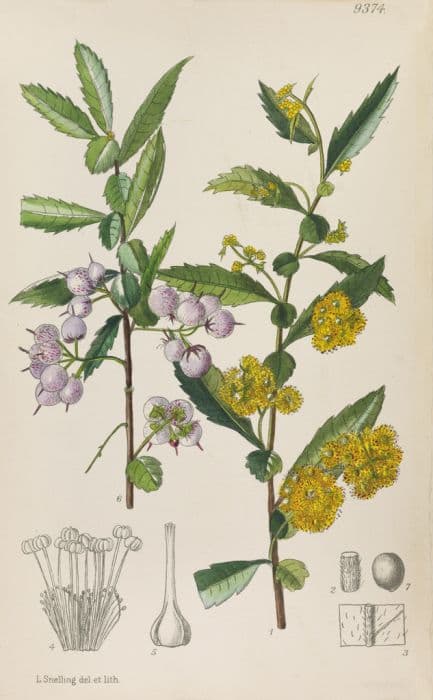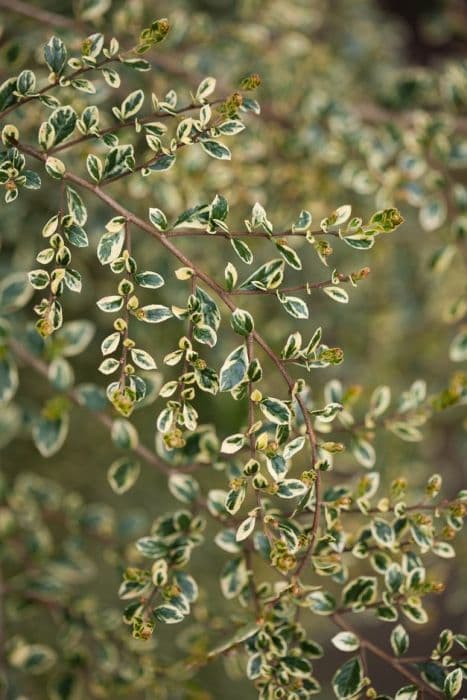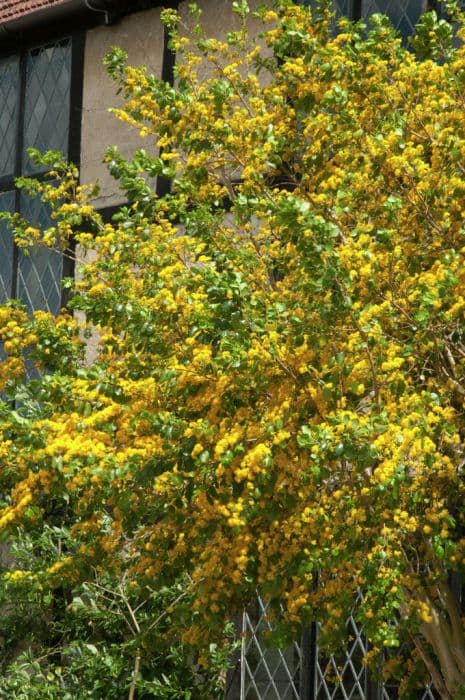Egyptian Willow Salix aegyptiaca

ABOUT
Salix aegyptiaca, commonly known as the Egyptian willow, is characterized by its distinctive narrow leaves which have a lance-shaped or willow-like appearance. The leaves are typically bright green, offering a fresh, vibrant look throughout the growing season. On the underside, the leaves may have a paler hue or a slightly silvery touch, contributing to the plant's unique visual appeal. During its blooming period, the Egyptian willow produces flowers in the form of catkins. These catkins are often pendulous, dangling elegantly from the branches, and can vary in color from yellow to greenish hues. The interesting textural contrast they provide makes this plant an attractive choice for ornamental purposes. The bark of the Egyptian willow is another striking feature, ranging from gray to brown, and it may exhibit a furrowed texture which adds to the plant’s overall visual interest. As the plant matures, this bark can become deeply ridged, providing a rugged natural aesthetic. Generally, the Egyptian willow's branches and twigs tend to grow in a somewhat twisted, spreading manner, giving it a somewhat unruly yet graceful form. The interplay of its delicate leaves, the decorative catkins, and the textured bark combine to make the Egyptian willow a distinctive plant with a pleasing appearance that can enhance various landscapes.
About this plant
 Names
NamesFamily
Salicaceae
Synonyms
Egyptian Willow, Musky Willow, Arabian Willow
Common names
Salix aegyptiaca.
 Toxicity
ToxicityTo humans
Salix aegyptiaca, commonly known as the Egyptian willow, is not generally considered toxic to humans. Members of the willow family contain salicin, a compound that is chemically similar to aspirin (acetylsalicylic acid). While willow bark has been used historically for its pain-relieving properties, consuming large quantities of willow bark or leaves can lead to toxicity, primarily because of the salicin content. The most common symptoms of salicin overdose are similar to aspirin overdose and may include nausea, vomiting, gastric irritation, and in severe cases, tinnitus (ringing in the ears), hyperthermia, increased breathing rate, confusion, or hemorrhaging. Therefore, although not highly poisonous, consuming parts of the Egyptian willow may have adverse effects and should be done cautiously, and only under the guidance of a healthcare professional.
To pets
Salix aegyptiaca, commonly known as the Egyptian willow, is not widely recognized as a toxic plant to pets. Similar to its effects on humans, willows contain salicin, which can be harmful in large quantities. When pets ingest significant amounts of willow bark or leaves, they might experience symptoms of salicin toxicity, which is akin to aspirin poisoning. This can include gastrointestinal upset, such as vomiting or diarrhea, and in more severe cases, it may lead to more serious symptoms like stomach ulcers, kidney dysfunction, or central nervous system effects such as seizures or coma. While the occasional chewing on willow branches or ingestion of leaves might not cause immediate harm, pet owners should monitor their animals for any signs of distress and consult a veterinarian if they suspect their pet has ingested a harmful amount of the plant.
 Characteristics
CharacteristicsLife cycle
Perennials
Foliage type
Deciduous
Color of leaves
Green
Flower color
Yellow
Height
15 feet [4.57 meters]
Spread
15 feet [4.57 meters]
Plant type
Tree
Hardiness zones
6
Native area
Eurasia
Benefits
 General Benefits
General Benefits- Erosion Control: Salix aegyptiaca has an extensive root system that can help stabilize soil and prevent erosion.
- Habitat Creation: This plant provides a suitable habitat and food source for various wildlife species.
- Shade and Shelter: Its canopy offers shade and shelter for both animals and humans, particularly in hot and arid environments.
- Ornamental Value: It can be used in landscape design for its attractive foliage and form.
- Windbreak: The plant can act as a windbreak, protecting smaller plants and reducing wind erosion.
- Biomass Production: Salix aegyptiaca can be used in biomass plantations for renewable energy production, owing to its fast growth.
- Soil Improvement: It contributes to soil fertility through leaf litter, which decomposes and enriches the soil.
- Phytoremediation: The plant has the potential for phytoremediation, helping to clean contaminated soil or water.
- Carbon Sequestration: It plays a role in carbon sequestration, capturing carbon dioxide from the atmosphere.
 Medical Properties
Medical Properties- Anti-inflammatory: Salix aegyptiaca contains compounds believed to reduce inflammation.
- Analgesic: The plant has been investigated for its potential to relieve pain.
- Antipyretic: It may help to reduce fever, similar to other members of the willow family due to the presence of salicylic-like compounds.
- Antimicrobial: Studies have shown the plant to exhibit some antimicrobial properties against certain pathogens.
- Wound healing: There is some evidence to suggest that it might promote wound healing due to its astringent properties.
 Air-purifying Qualities
Air-purifying QualitiesThis plant is not specifically known for air purifying qualities.
 Other Uses
Other Uses- Crafting material: Salix aegyptiaca branches can be used in basket weaving due to their flexibility and strength.
- Fodder: The leaves of the tree can be used as fodder for livestock, particularly in times of food scarcity.
- Erosion control: The root system of Salix aegyptiaca helps stabilize riverbanks and prevent soil erosion.
- Noise barrier: Dense plantings of this species can act as a sound barrier, reducing noise pollution.
- Windbreak: The trees can be planted in rows to serve as windbreaks, protecting crops and soil from wind damage.
- Ornamental use: With its attractive foliage and growth habit, Salix aegyptiaca can be used as an ornamental plant in gardens and parks.
- Tannin production: The bark contains tannins that can be extracted and used in leather production.
- Mood enhancement: Being around this tree and its natural environment may have a positive impact on an individual's mood due to its aesthetic appeal.
- Shade provider: Its canopy offers shade and can reduce local temperatures, making it valuable in hot climates.
- Art Supplies: The flexible branches can be used to create frames for paintings or as part of mixed-media art projects.
Interesting Facts
 Feng Shui
Feng ShuiThe plant_name is not used in Feng Shui practice.
 Zodiac Sign Compitability
Zodiac Sign CompitabilityThe plant_name is not used in astrology practice.
 Plant Symbolism
Plant Symbolism- Flexibility – The willow branches of the Salix aegyptiaca, commonly known as the Egyptian willow, are known for their flexibility, symbolizing the ability to adapt and bend without breaking.
- Grief and Mourning – Willow trees are often associated with sorrow and mourning, reflecting the weeping form of many willow species.
- Healing – In historical contexts, the willow has been seen as a tree of healing due to the salicylic acid in its bark, which is an ingredient used in aspirin.
- Intuition and Dreams – Willow trees are sometimes connected to the moon and water, elements often associated with intuition, the subconscious, and the world of dreams.
- Protection and Safety – Traditionally, willows were believed to offer protection, and people would carry willow amulets or place branches around their homes to ward off evil.
- Love and Loss – The bittersweet nature of the weeping willow can also represent the enduring nature of love, even through times of loss and hardship.
 Water
WaterThe Egyptian Willow (Salix aegyptiaca) should be watered deeply enough to saturate the root zone without leaving standing water, which typically requires approximately 1 to 1.5 gallons for a young tree every week during its growing season. In hot or windy weather, you may need to increase the frequency to twice a week, and during cooler months, reduce the watering to once every two weeks or less, depending on the soil moisture. Always check the top inch of the soil before watering; if it feels dry, the plant needs water. Overwatering can lead to root rot, so ensure proper drainage.
 Light
LightThe Egyptian Willow thrives best in full sun to partial shade. It should be placed in a location where it can receive at least 6 hours of direct sunlight daily. The ideal spot for this willow would be in an open area of the garden that isn't heavily shaded by taller trees or structures, allowing the plant to grow strong and healthy.
 Temperature
TemperatureThe Egyptian Willow is adaptable to a variety of climates but prefers temperatures ranging from 30°F to 85°F. It can survive short periods of colder temperatures down to about -10°F and can handle heat above 85°F as long as it's well-watered. For optimal growth, maintaining an environment within the preferred temperature range is best.
 Pruning
PruningPrune the Egyptian Willow during its dormancy in late winter or early spring to remove dead or damaged branches and to shape the tree. Thinning the canopy every few years promotes better air circulation and light penetration, which is vital for the health of the plant. Prune sparingly, as excessive cutting can stress the willow, and always use sharp, clean tools to make clean cuts.
 Cleaning
CleaningAs needed
 Soil
SoilThe Egyptian Willow (Salix aegyptiaca) thrives best in well-draining soil with abundant organic matter. A good mix would be one part loam, one part sand or perlite, and one part peat or well-rotted compost to ensure fertility and drainage. The preferred soil pH for this willow is slightly acidic to neutral, ranging from 6.0 to 7.0.
 Repotting
RepottingEgyptian Willows, being fast-growing trees, generally do not need frequent repotting. However, if grown in a pot, they may need repotting every 2-3 years to ensure they are not root-bound and to replenish the soil with nutrients.
 Humidity & Misting
Humidity & MistingEgyptian Willows (Salix aegyptiaca) are adaptable but prefer moderate to high humidity levels. They can tolerate lower humidity but will benefit from conditions that mimic their natural moist and riverine habitats.
 Suitable locations
Suitable locationsIndoor
Place in bright light, keep soil moist, and ensure high humidity.
Outdoor
Full sun to partial shade, moist soil, protect from dry winds.
Hardiness zone
6-8 USDA
 Life cycle
Life cycleSalix aegyptiaca, commonly known as the Egyptian Willow, begins its life cycle when seeds disperse in the late spring, relying primarily on wind and water for dispersal. Germination occurs rapidly in favorable moist soil conditions, with seedlings quickly developing roots and shoots. The plant enters a juvenile growth phase marked by rapid stem and leaf development, where sufficient sunlight and water are crucial for its growth. As the Egyptian Willow matures, it reaches the reproductive stage where it produces catkins, which are pollinated by insects, leading to seed formation. After several years, the Egyptian Willow reaches maturity and may continue to grow and reproduce for decades, given its ability to sprout new shoots from the base if the main stem is damaged. Seasonal changes instigate periods of dormancy, especially in colder climates, with the plant shedding leaves in the fall and entering a resting phase during winter.
 Propogation
PropogationPropogation time
Spring-Early Summer
The most popular method of propagation for the Salix aegyptiaca, commonly known as the Musket Willow, is through cuttings. This is ideally done in late winter or early spring before the buds break into full leaf. To begin, healthy year-old branches are selected and cut into sections approximately 6 to 8 inches (15 to 20 centimeters) in length, making sure each cutting has at least a couple of buds. The cuttings can then be planted directly into moist soil with about two-thirds of their length buried. This encourages rooting and helps establish the cuttings. To improve success rates, the soil should be kept consistently moist until the cuttings have fully rooted and show signs of growth.









